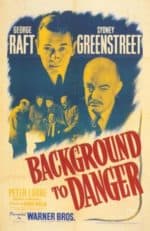Love in the midst of intrigue!
Many films were made after the gross successes of The Maltese Falcon and Casablanca, mostly by Warner Brothers and repurposing various reconfigurations of the original cast of those two films, though all excluded Humphrey Bogart and Ingrid Bergman. The “hottest” combination of these respins were always pairing of Peter Lorre and Sydney Greenstreet. Among these are Three Strangers, The Mask of Dimitrios, The Verdict, and Background to Danger. Other imitations (at least in spirit) include 1944’s The Conspirators.
Few mention today Background to Danger, one of the films repairing Greenstreet and Lorre in a futile attempt to rekindle the magic that was Casablanca. Perhaps that is the better option, though Background to Danger film sports more than enough top notch talent among its credits.
In addition to the aforementioned Greenstreet and Lorre we also get Brenda Marshall and Turhan Bey among the supporting players, though the latter is almost in a bit part. Behind the camera we have Raoul Walsh directing a screenplay from W.R. Burnett based on an original work by Eric Ambler.
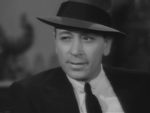 In the lead role- and here’s where it starts to fall apart- is George Raft. Ironically given his penchant for passing on great roles taken up by Humphrey Bogart, here he is in a role which surely was written with Bogart in mind from the start.
In the lead role- and here’s where it starts to fall apart- is George Raft. Ironically given his penchant for passing on great roles taken up by Humphrey Bogart, here he is in a role which surely was written with Bogart in mind from the start.
Background to Danger is a turgid little movie with a lot going on, but even at 80 minutes it seems overly drawn out and becomes rather boring. Centering on the machinations to get Turkey to enter the war on the side of the Germans, it seems woefully weak on plot but mighty strong on mere ‘running around.’ By the end of the film the viewer- if still engaged- is exhausted. A better than average movie, especially in production values, but one only a completist would rewatch.
Raft is Joe Barton, a machinery salesman traipsing through Turkey and Syria. In sharing a train compartment on a trip from Aleppo to Ankara, he meets and momentarily befriends the young Ana Remzi (Osa Massen). On learning that he’s an American, she asks him to hold on to the last of her family fortune in a small envelope, knowing that she’ll loose it at the border.
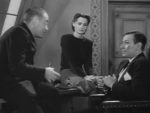 In getting of the train he opens the envelope to find not currency but rather marked up maps of Turkey, presumably detailing plans for an upcoming Soviet invasion of the country. Joe tries to return the envelope to Ana at her hotel only to find her dead.
In getting of the train he opens the envelope to find not currency but rather marked up maps of Turkey, presumably detailing plans for an upcoming Soviet invasion of the country. Joe tries to return the envelope to Ana at her hotel only to find her dead.
Following a lead from the hotel, Barton comes across the brother-sister duo of Nikolai and Tamara Zaleshoff (Lorre and Marshall). After some rather needless banter back and forth, it comes out that the two are Soviet spies trying to regain the plans. Not because they are real, mind you, but rather because they are fake- created by the Nazis (led by Greenstreet) to instigate Turkey joining the war on the German side.
Though the Zaleshoffs push Barton for the envelope, he refuses (it turns out he is an American agent, no less), having stuck it to the underside of a table in his hotel room. However, the Germans come to his hotel room masquerading as the police and take Barton away for questioning, where Colonel Robinson (Greenstreet) interrogates him.
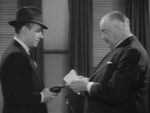 Though Barton eventually escapes he learns that Robinson has ultimately found the hidden papers in his room and has arranged for a pro-German newspaper to publish them. At a fight at the newspaper offices, Barton destroys the plates with the plans on them and also forces Robinson to burn the originals, removing all trace of the bogus plans.
Though Barton eventually escapes he learns that Robinson has ultimately found the hidden papers in his room and has arranged for a pro-German newspaper to publish them. At a fight at the newspaper offices, Barton destroys the plates with the plans on them and also forces Robinson to burn the originals, removing all trace of the bogus plans.
Foiled, Robinson is sent back to Berlin in disgrace and Barton and Tamara are off to their next mission in Cairo. Unfortunately Nikolai’s been killed in an earlier scuffle. It sounds a lot better on paper than it actually is.
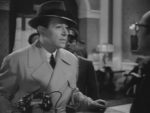 All the action is quick and well done as we’d expect from a Walsh film. The sets and music also work well, though obviously most all of this was shot back on the studio lot. It’s almost as if Walsh knows the limitations of what he has to work with in terms of cast and plot and keeps up a recklessly fast past to distract us from these obvious shortcomings. Where things fall apart is the casting, or more accurately the usage of the cast.
All the action is quick and well done as we’d expect from a Walsh film. The sets and music also work well, though obviously most all of this was shot back on the studio lot. It’s almost as if Walsh knows the limitations of what he has to work with in terms of cast and plot and keeps up a recklessly fast past to distract us from these obvious shortcomings. Where things fall apart is the casting, or more accurately the usage of the cast.
Peter Lorre, for all his talent and screen time here, comes off as a goofy foil at best. To most statements he responds with a wry shrug and commenting, “I don’t know what to do with this guy!” or something similar. That works once or twice but after a dozen or sayings we’d all like to see something more. He’s clearly having fun in the role but Nikolai is a one-trick pony.
Brenda Marshall and Turhan Bey are even more perplexing. Marshall’s given little to do but play along with Lorre’s silliness and Bey’s role coming in later in the picture isn’t fleshed out enough to have any merit.
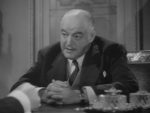 Greenstreet on the other hand comes off well as the gruff Nazi ringleader, with his only flaw being his obsession with his fake plans. Wouldn’t it have been much easier just to get another copy or create an entirely different set?
Greenstreet on the other hand comes off well as the gruff Nazi ringleader, with his only flaw being his obsession with his fake plans. Wouldn’t it have been much easier just to get another copy or create an entirely different set?
Sadly most of the above could be overlooked if we weren’t saddled with George Raft in the lead role. Always wooden and with a limited range, he brings a solidly oaken performance to Background to Danger. Perhaps director Walsh had all the footage where Raft shows emotion cut- needless to say Raft’s constantly perfect deadpan response to all that’s going on around him spread treelike roots throughout the entire production.
Though less well known than what could be termed its sister film, Mission to Moscow, Background to Danger is also a decidedly pro-Soviet picture due to the time in which it was filmed, 1943. At best Danger is a bit of a historical oddity, one of the numerous times the studios (namely Warners) dipped back into the Casablanca tinged waters in a made attempt to recapture that darned genie.
